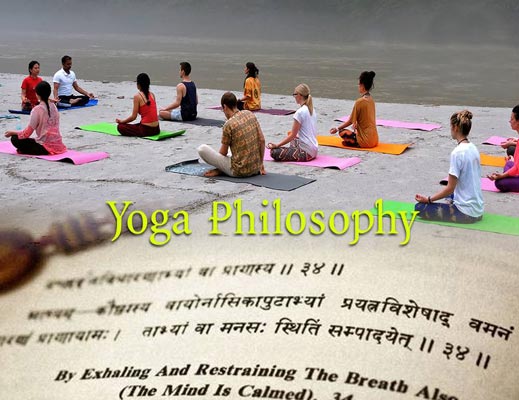Recognition of United Nations for the celebrations of International Yoga day on 21
st June is great mile stone in the history of yoga. There is an increased awareness about its principles and practices around the world. Every year many people around the world travel to
Learn Yoga in India. The surge in the career opportunities in yoga is another significant factor for its proper study and practice.
Yoga sutra of Patanjali is one of the most authoritative texts on the subject. Practitioners both in the east and west are interested to deepen their knowledge. The vast literature of this ancient wisdom is condensed in the form of 196 Sutras. The growth of yoga took place over thousands of years. But for beginner in this journey, it is very hard to understand all the aspects.
Yoga Teacher Training Course in India imparts the comprehensive knowledge of the text. Rishikesh is one of the best locations known for these programs.
Sutra or Aphorism is compact, dense sentence in Sanskrit. It is composed of minimum letters, without ambiguity being meaningful. It is universal in application and flawless. The classical work of compilation of Yoga Sutras was carried out by Maharishi Patanjali. The structured organization of the literature happened around fourth century AD according to the commentary of Vyasa on yoga principles.
The author of the sutras calls his notable work as discipline, this indicates that, he never claims to be the founder of the system. He adapts Samkhya philosophy as its foundation. It is one of the six systems of Indian philosophy. The purpose of yoga is harmony in life. This is termed as Samadhi. The discipline practiced on all its aspects brings the regulation of the mental modifications resulting into peace of mind.
The Curriculum of Yoga Philosophy
The curriculum of yoga sutras spreads across four chapters known as Pada or units. The author develops the organization of the concepts in a sequential process having a mutual relationship.
The four chapters are;
1. Samadhi Pada - It is called as concentration. The aphorisms in this chapter deal with the concepts of yoga psychology. He discusses the nature and number of mental medications. Direct perception, inference and testimony are outlined as the means of valid knowledge. Obstacles and their impact on physical and mental health as well as the concept of Ishwara, peace of mind are enumerated.
2. Sadhana Pada - Sadhana is dedicated intense practice. The first part of the second chapter on this topic covers the causes of human miseries. It will answer the question "Why one should study and practice yoga?" The study of synopsis of afflictions helps in the realization of the cause and effect, as well as freedom from the bondages of the sufferings. Second part of this section develops the knowledge on important principles and practices of Ashtanga yoga. They include the art of yoga for ethical preparation, the discipline of the body, breath and sense control.
3. Vibhuti Pada - Vibuti means the divine powers. Concentration, meditation and samadhi are placed in the third chapter as the last three limbs. The applications of the controlled mind are revealed with various types of divine powers. They are the result of high intensity practice of eight limbs. The mind and body are equipped with perfect health, happiness and harmony in the life.
4. Kaivalya Pada - The fourth chapter is on the nature of liberation. The real purpose and techniques of yoga are experienced at this stage of sadhana. The contents of this chapter are understood by a serious student of yoga. Curriculum in this part is about the philosophical problems of life, liberation from these problems.
Systematic study of yoga is helpful to understand all these aspects as they are interconnected to each other. The text has great influence on the development of yoga traditions in India. Since these sutras written in Sanskrit, it is useful to understand the subject with the help of translations and commentaries. Experienced yoga masters are the helpful resources to understand the sutras.
Meta Physics and Foundations of Yoga Philosophy
Purusha and prakriti are the two realities conceptualized in the metaphysics of yoga. Self and supreme consciousnesses are experienced as two different entities. Yama and Niyama along with Triguna principles form the basis of ethical life in yoga. These are inherited from the Samkhya philosophy.
Many of the Indian philosophical schools have very strong foundation in their traditions from Yoga sutras. They apply their methods or practices along with the principles. These are found both in the orthodox and heterodox systems.
Bagavad gita has beautifully outlined these teachings as the paths of Bhakti, Jnana and Karma. The text also brings the light on the practice of meditation. The preparation in terms of the seat, diet and lifestyle are meticulously discussed. We can see the integration of principles of alignment for the proper posture of meditation which is commonly found in Hatha yoga poses. Lord Krishna says practice and dispassion are the two means for the mind control. Teachings of Patanjali are revolving around these two terms for the practical training in Yoga.
Teachings of Samkhya are fundamental contributions for Yoga philosophy. The knowledge of nature of pure spirit is revealed through this philosophy of ancient India. Based on this, the principles and practices are systematically developed as Ashtanga Yoga. S. Radhakrishnan, the author of Indian Philosophy, outlines the doctrine of gunas, ethical significance, the concept bondage, mechanisms of knowledge for freedom in Yoga.
Yoga Psychology has many aspects which are similar to Buddhism. The connection of subejct and object, chitta, emotions, perception, conception, feelings, impressions and intellectual reasoning are explained in the sutras. The noble truth of suffering, its causes, cessation and the means to cease are outlined with respect to cause and effect theory. Buddha found to be very serious practitioner of yoga philosophy and practice. The principles of morality, purifications of emotions, law of karma, nonviolence are highly valued both in the teachings of Buddha and Yoga.
Ethics in Yoga are very ancient principles for the quality of life experience. They are significant for the health of the society. The harmony of the self with his society is essential for mental peace and emotional stability. The teachings of Rig veda on the truth furnishes the standards of morality. The epics and the transitions of Upanishads continue to carry these teachings .Apart from this, they also outline the meaningful life with goal of attaining liberation from the bondages of sufferings and miseries of the human life. Essence of Yoga practice fulfills this ultimate aim as Samadhi.
Yoga techniques and its teachings based on its philosophy have profound influences in modern life. They are instrumental for the promotion of positive physical and mental health.
Latest Blog
Learning the principles and techniques of yoga in Rishikesh is great accomplishment. The salubrious climate of the city...
Himalayas are the stunning attractions of the beauty on the earth. There is abundant divine energy within the ranges of these...
Rishikesh is world renowned destination to learn yoga in India. The city is nestled in the lap of the beautiful nature...



